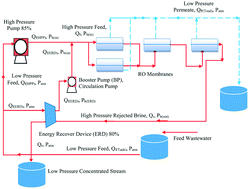Significant energy savings by optimising membrane design in the multi-stage reverse osmosis wastewater treatment process
Abstract
The total energy consumption of many reverse osmosis (RO) plants has continuously improved as a result of manufacturing highly impermeable membranes in addition to implementing energy recovery devices. The total energy consumption of the RO process contributes significantly to the total cost of water treatment. Therefore, any way of keeping the energy consumption to a minimum is highly desirable but continues to be a real challenge in practice. Potential areas to explore for achieving this include the possibility of optimising the module design parameters and/or the associated operating parameters. This research focuses on this precise aim by evaluating the impact of the design characteristics of membrane length, width, and feed channel height on the total energy consumption for two selected pilot-plant RO process configurations for the removal of chlorophenol from wastewater. The proposed two configurations, with and without an energy recovery device (ERD), consist of four cylindrical pressure vessels connected in series and stuffed with spiral wound membranes. A detailed steady-state model developed earlier by the authors is used here to study such an impact via repetitive simulation. The results achieved confirm that the overall energy consumption can be reduced by actually increasing the membrane width with a simultaneous reduction of membrane length at constant membrane area and module volume. Energy savings of more than 60% and 54% have been achieved for the two configurations with and without an ERD respectively using process optimization. The energy savings are significantly higher compared to those of other available similar studies from the literature.



 Please wait while we load your content...
Please wait while we load your content...